One of the crucial components of a successful fishing trip is choosing the right fishing technique to get your prey to bite. There’s a lot of finesse and knowledge that goes into mastering them, and often, you can find different variations of the same technique in different parts of the world. In a unique way, how a fishing technique evolves is closely connected to the local culture and available fish species.
The thing is that there are quite a few techniques out there, so things can get overwhelming quickly. That’s why we decided to share with you this handy guide and start you off easily. We’ll cover the most popular fishing types and techniques you can use to get that trophy catch to bite, as well as some unique approaches and additional tips. Whether you’re fishing for the first time or getting ready to try out something new, this guide can help you out. Let’s jump right in!
What are you interested in?
Types of Fishing
First of all, let’s take a closer look at some of the most popular types of fishing. These types encompass different techniques within them. But before we get into the nitty-gritty details, here’s an overview of what you can expect when you’re out on a charter and they mention deep sea fishing, inshore fishing, surf fishing, or anything in between.
Inshore Fishing
If you like to fish, but don’t like going too far from shore, then inshore fishing is perfect for you. The water in which you’ll be casting your line is usually up to 20 feet deep, but that doesn’t mean you can’t get a fantastic bite. Depending on where you are, you can target a wide variety of inshore species that also happen to be incredible fighters.
Anything from Redfish, Spotted Seatrout, and Flounder to Striped Bass, Sheepshead, and Tarpon is in the cards, but that’s just the best of the best, there are dozens of fish you can catch. If you’re a beginner angler or you’re going out with a family, inshore fishing is a great place to start.
Nearshore Fishing

The definition for this type of fishing changes from state to state, from country to country. Generally speaking, nearshore fishing takes place in waters deeper than 20 feet, up to a few miles from the shore. You’re not exactly in the big game realm yet, but great catches can definitely happen. Reef and wreck fishing are especially productive in nearshore waters.
On the East Coast and in the Gulf of Mexico, you can chase Snapper, Grouper, Mackerel, Sharks, Cobia, and many more. On the West Coast, you can find good Salmon, Halibut, and Rockfish nearshore. The species and fishing techniques will vary from one location to another, but you’ll have a lot of fun. When it comes to nearshore fishing trips, even just a few hours on the water can result in a formidable bounty.
Deep Sea Fishing

This is the pinnacle of saltwater sportfishing – also known as offshore fishing and big game fishing. There’s a difference between offshore and deep sea action, though a lot of people use them as synonyms. Offshore angling happens up to 9 miles from land, while deep sea fishing happens in waters that are more than 100 feet deep.
As its name says, this type of action will put you on some of the biggest and hardiest fish on the planet. Marlin, Tuna, Sailfish, Swordfish, Mahi Mahi, massive Grouper, and Snapper can all be caught while deep sea fishing. When you book a deep sea charter, bear in mind you’ll probably spend a couple of hours getting to the fishing grounds, so be prepared for a trip that will be worth the prize.
River Fishing

Casting a line or two from a river bank is what freshwater fishing is all about. You can also do wade fishing, fly fishing, or head to the deeper parts of the river on a boat for the chance of a bigger catch. River fishing is versatile and you can try a bunch of fishing techniques until you find what works best for you. Tackle and setups for this type of freshwater fishing can be straightforward or as elaborate as you want them to be. The beauty of it lies in its simplicity, and you can use a very simple setup to get excellent results.
When it comes to favorite catches, the sky’s the limit! Think Trout, Bass, Bass, Northern Pike, Catfish, Carp, and the list goes on. River fishing is very accessible for solo anglers, all you need is some basic tackle, a willingness to wake up early, patience, and a bit of good luck.
Lake Fishing

If you’ve got a prolific lake near you, don’t miss out on hours of fun you could spend exploring it. Similarly to river fishing, lakes are beginner-friendly fisheries and, in them, you can find a great variety of freshwater game fish. Bear in mind that lakes usually have a couple of species they’re famous for, and that’s what you should focus on.
It can be anything from Lake Trout and Walleye on the Great Lakes to Black Bass, Trout, Salmon, and similar freshwater inhabitants all over the world. Catfish and Carp are very popular catches as well, so you’ve got plenty of options. You can use similar tackle as you would on rivers and streams, which makes your life easier. Also, pay attention to special regulations that lakes have when it comes to creel limits and additional permits.
Popular Fishing Techniques
Each of the abovementioned types of fishing offers a variety of techniques within them that any eager angler can try. Some of them can be used both in saltwater and freshwater with certain adjustments – trolling, jigging, and bottom fishing fit the bill. If you’re just starting off, you don’t have to know them all, your guide will explain the basics, and you can take it from there. Here are some of the most popular techniques you might use to hook into your trophy catch.
Trolling
Of all the angling techniques, trolling is probably the most popular and versatile. Its principle is very simple – you rig your setup with a lure or a piece of bait, and let it move behind the boat to simulate a live bait fish. When you get a bite, you’ll hear the reel scream, you pick up the rod, and the battle starts. The best part is that trolling is effective in both freshwater and saltwater.
This means that you can successfully target a slew of game fish from both realms. Think Salmon, Bass, and Walleye in freshwater and Barracuda, Wahoo, Billfish, and Tuna in saltwater. Basically, trolling is the path to all the favorite A-listers for beginners and seasoned anglers alike.
Bottom Fishing

Some fish are speedsters with an impeccable predatory instinct, while others prefer their prey to come to them. The latter are bottom feeders, masters of ambush and disguise. Unlike pelagics, these guys will wait for bait fish to unsuspectingly swim by and then attack. That’s where bottom fishing comes in. All you have to do is rig your setup with a delectable piece of bait, drop it near the bottom, and let nature take its course.
You can bottom fish in rivers and lakes and get yourself nice Bass, Perch, Catfish, and Carp. Prefer saltwater? No problem, Snappers, Groupers, Flounder, Halibut, Amberjack, and Tilefish are the most sought-after catches. Just like with trolling, you can tweak bottom fishing however you’d like to serve your angling ambitions. That’s what makes it so great!
Fly Fishing

While we categorize fly fishing as a technique, avid fly anglers would argue that it’s a way of life. Fly fishing is one of the most complex and unique techniques around – so much so that it can be considered an art form. It takes time to perfect fly casting because you’re using a lightweight line to cast a “fly” which will entice your fish. The “flies” look and float like insects on the water.
If presented properly, these can trick even the most finicky of fish to bite, which is the technique’s main allure. Trout fly fishing is world-famous, but you can also go after Bass, Salmon, and Panfish in freshwater. Saltwater anglers have a lot of fun targeting Redfish, Snook, Bonefish, and Tarpon inshore. But, if you’re the ultimate thrill seeker, try fly fishing for Billfish and Tuna, you’ll never forget the experience!
Bowfishing

For this fishing technique, the clue is in the name. If you’d like to try something new and unique, then bowfishing won’t disappoint. All you need for this experience is a bow and arrow adjusted to your fishing needs, and the adventure can begin! You’ll also need waters that are somewhat transparent so that you can see your target. As you see the fish, release the arrow rigged with a fishing line and try to hit it.
You can go bowfishing during the day, but the best action is at night. Your bowfishing charter will use lights around the boat to attract night feeders. The most common freshwater catches are Carp, Garfish, and Catfish, as well as Flounder, Sheepshead, and Redfish in saltwater.
Spearfishing

Another one-of-a-kind fishing technique is spearfishing. Using a speargun for your fishing escapades is as close as you can get to being face-to-face with your catch. Depending on how deep you want to go, you might also need some basic diving training. The approach is pretty straightforward – you get your speargun and snorkeling/diving gear, jump into the water, and wait for the fish to swim by. Then, do your best to aim and hit your target, which will be moving fast.
You can catch pretty much any saltwater fish you can think of this way, which is an additional perk. Bear in mind that spearfishing regulations vary from country to country, so know the law before you go.
Ice Fishing

Finally, we’ve got a fishing technique for all you winter lovers out there. Ice fishing gives you access to your favorite activity even when the traditional fishing grounds are frozen solid. All you need is basic ice tackle and lots of layers to keep you warm while waiting for the bite. You’ll need to drill through several inches of ice to get to the fish, but it will be worth it.
As for what you can catch, anything from Yellow Perch and Walleye to Northern Pike and Lake Trout is in the cards. The species will vary depending on the location. Ice fishing is a great bonding experience, and, as long as you don’t mind the cold, you’re in for a blast.
Unique Fishing Techniques
There are many traditional fishing techniques around the world that have been used for centuries, and then there are a few that were invented thanks to human creativity and technology. And while some are more productive than others, most of them definitely deserve to be mentioned.
Let’s take a look at some unique techniques you might have never heard of. And, if you’d like more info, check out our complete list of weird fishing techniques. Maybe you’ll find something that tickles your fancy!
Not all of these fishing techniques can strictly be called fishing, but they’re fun to try out. If you’re looking to shake things up, well, you’ve got your choices. Bear in mind that you’ll need to go to New Zealand to try kontiki fishing and that magnet fishing won’t actually put you on fish, but metal scrap. But hey, why not try everything once?
Additional Tips about Fishing Techniques
Figuring out fishing techniques can be intimidating, especially if you’re just starting to fish, but the good news is that you can take it as slowly as you’d like. There are also different circumstances that should dictate which approach you should take, but don’t worry, we’ve got you covered! Whether you’re looking for some guidance for night fishing or how you can camp and fish, these articles will help you out.
As you can see, fishing techniques can be a complex topic that deserves a dedicated encyclopedia. Don’t let that scare you, because they can also be quite simple – as long as you’ve got a seasoned angler to show you the ropes! That’s why it’s always a good idea to consider going fishing with a guide. And for that, you don’t even have to travel far, there’s usually someone in your area to help you out.
Our best advice is to try a few different types of fishing and techniques before you decide what you really like. Then you can spend some time honing your skills and catching awesome fish before you move on to the next technique you want to master. It’s probably going to take some time and patience, but that’s what fishing is all about!
FAQs
The post Fishing Techniques: The Complete Guide appeared first on FishingBooker Blog.
https://ift.tt/0W2BURZ
0 Comments
Enregistrer un commentaire